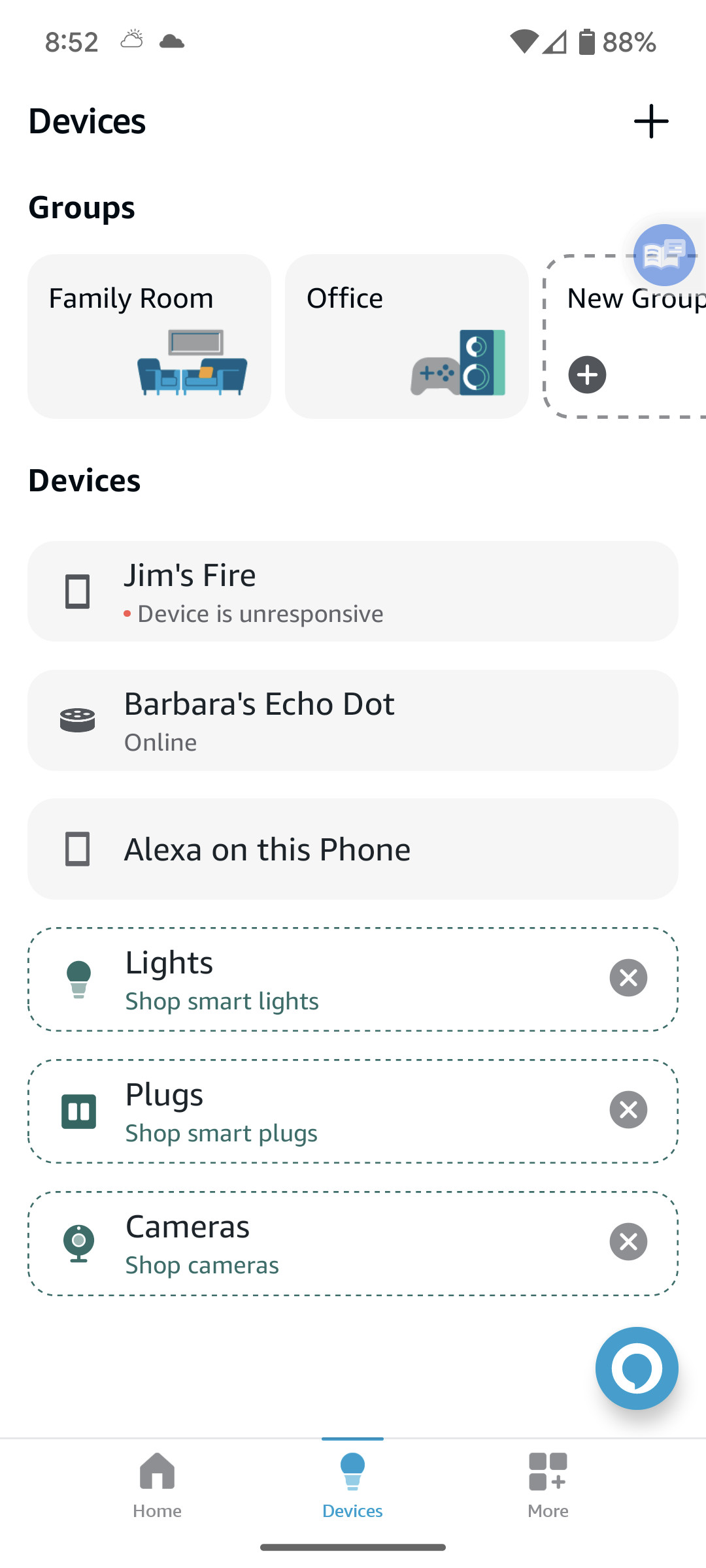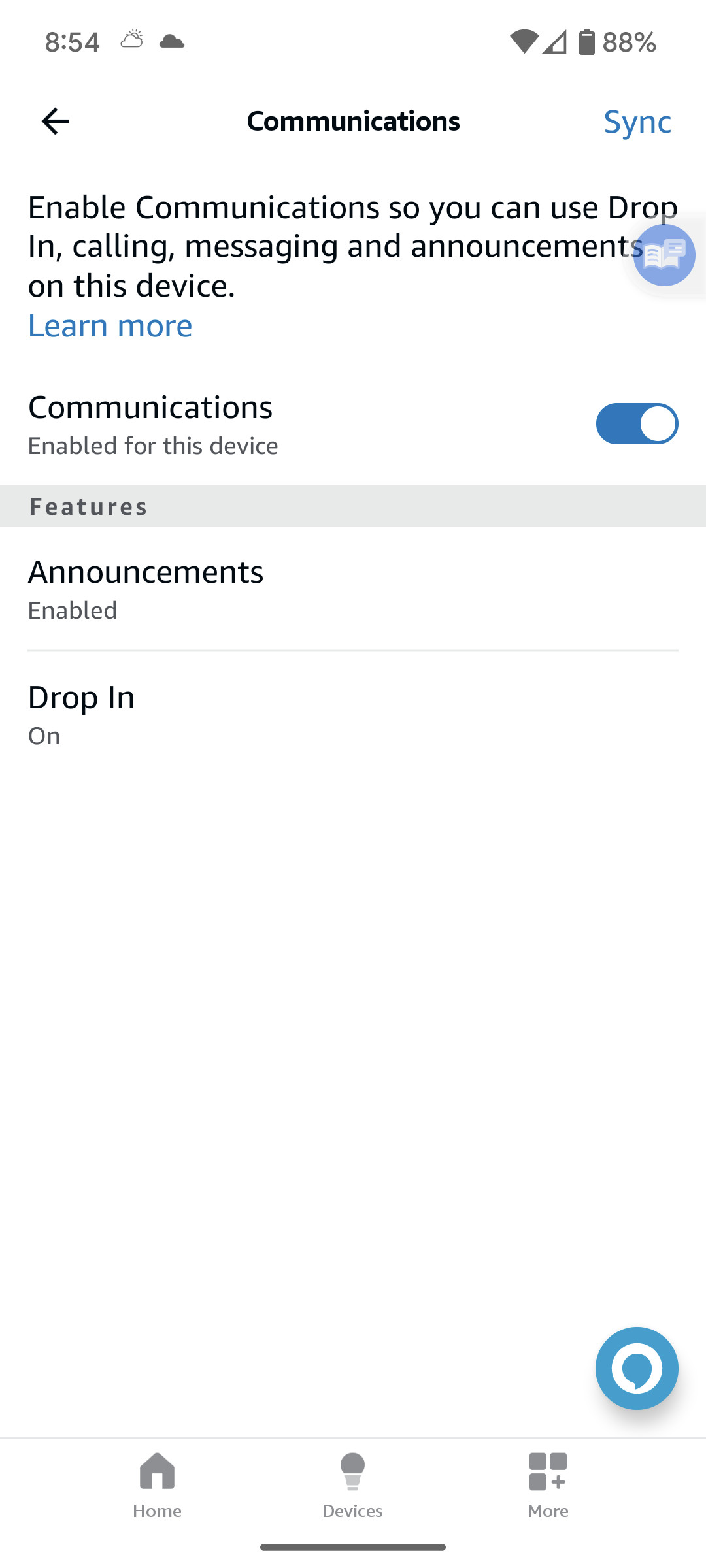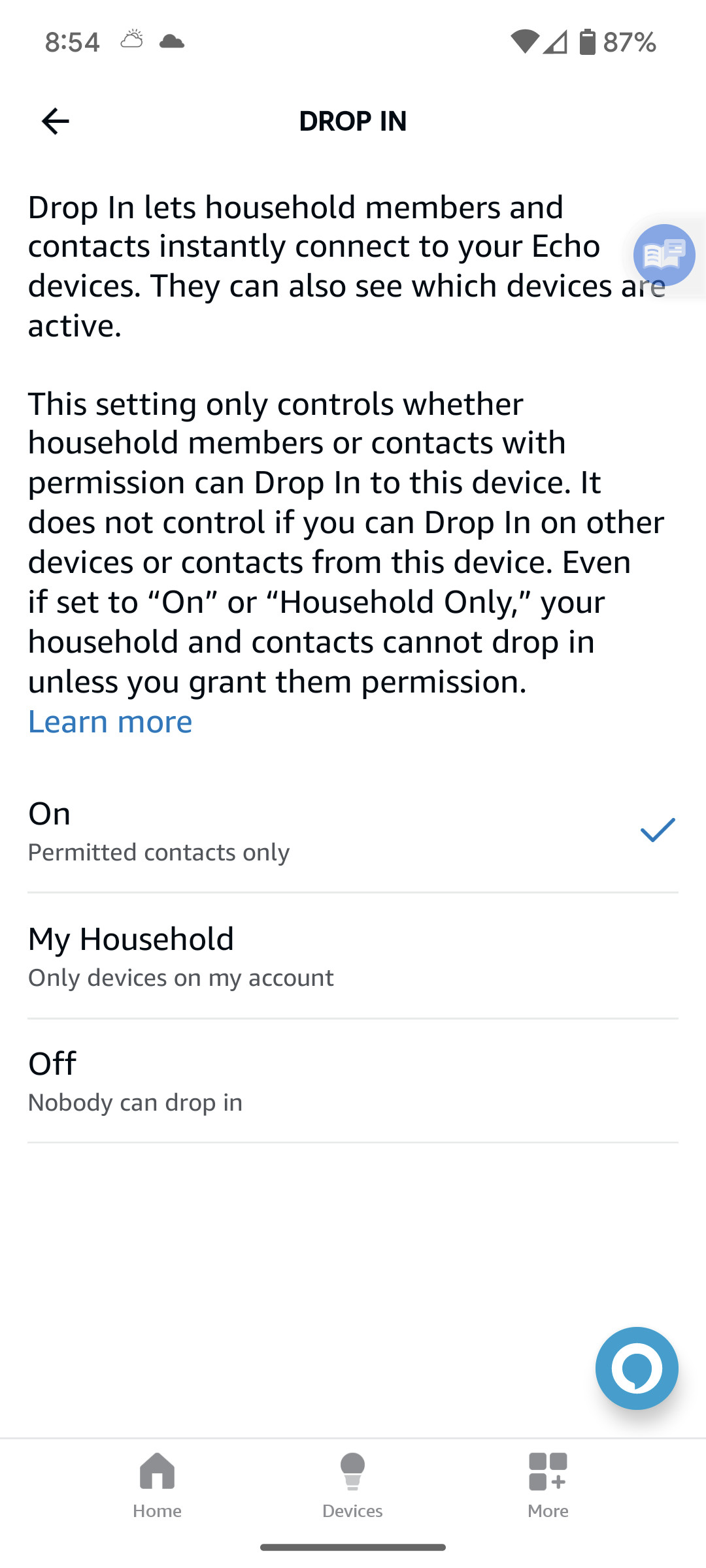Alexa can absolutely be used as an intercom system, offering a convenient way to communicate throughout your home. This article at alexlampert.com explores how to set up and use Alexa devices as an intercom, highlighting the benefits and features for modern home communication. Dive in to discover how Alexa enhances architectural designs by providing seamless, hands-free communication, improving home automation and overall connectivity. Key phrases covered: voice commands, smart home integration.
1. What Is Alexa and How Does It Work?
Alexa is Amazon’s voice-controlled virtual assistant, designed to simplify various tasks through voice commands. It operates using speech recognition, natural language processing, and other AI technologies.
1.1. Understanding Alexa’s Core Functions
Alexa’s primary function is to respond to voice commands, offering a hands-free way to interact with technology. According to research from the University of Southern California’s School of Engineering, voice-activated systems like Alexa improve user interaction by 60% compared to traditional interfaces. Alexa’s capabilities include:
- Playing music: Accessing playlists, radio stations, and podcasts.
- Setting alarms: Managing schedules and reminders.
- Providing information: Answering questions about weather, news, and general knowledge.
- Controlling smart home devices: Managing lights, thermostats, and locks.
- Making calls and sending messages: Connecting with contacts.
1.2. Alexa-Enabled Devices: Echo, Echo Dot, and More
Alexa is integrated into a range of devices, each designed for different needs and locations within your home. The most common devices include:
- Echo: The original Alexa device, offering robust sound and voice recognition.
- Echo Dot: A smaller, more affordable option ideal for bedrooms and smaller rooms.
- Echo Show: Devices with a screen, allowing for video calls, visual information, and more interactive experiences.
- Fire Tablets: Tablets with Alexa integration, providing versatility for entertainment and information.
These devices use microphones to capture voice commands and connect to your home’s Wi-Fi network to access the internet. This connectivity enables Alexa to process commands and provide relevant responses.
2. Can Alexa Function as an Intercom System?
Yes, Alexa can indeed function as an intercom system, offering a modern and convenient way to communicate within your home. The “Drop In” and “Announce” features make this possible.
2.1. The “Drop In” Feature Explained
The Drop In feature allows you to instantly connect to another Alexa-enabled device in your home without requiring anyone to answer. This is particularly useful for:
- Checking on family members: Especially children or elderly relatives.
- Quick communication: Asking a quick question without needing to shout across the house.
- Monitoring different rooms: Ensuring safety and security.
To use Drop In, the feature must be enabled on both the calling and receiving devices. You can specify which contacts or devices are allowed to Drop In for added privacy.
2.2. Using the “Announce” Feature for Broadcast Messages
The Announce feature lets you broadcast a message to all Alexa devices in your home simultaneously. This is ideal for:
- Family announcements: Dinner is ready, it’s time to leave, etc.
- General reminders: Reminding everyone about appointments or tasks.
- Emergency notifications: Quickly alerting the entire household to an urgent situation.
To use Announce, simply say, “Alexa, announce…” followed by your message. The message will then play on all connected devices.
2.3. Limitations and Considerations
While Alexa offers a convenient intercom solution, there are limitations to consider:
- Privacy concerns: Drop In allows immediate access, which may raise privacy issues.
- Dependence on Wi-Fi: Functionality relies on a stable Wi-Fi connection.
- Voice recognition accuracy: May struggle with accents or background noise.
- Device placement: Optimal performance requires strategic placement of devices.
Understanding these limitations can help you effectively integrate Alexa into your home’s communication system.
 Alexa Devices Page
Alexa Devices Page
3. Setting Up Alexa as an Intercom System
Setting up Alexa as an intercom system involves enabling the Drop In feature, managing permissions, and understanding how to initiate intercom calls. Follow these steps to get started.
3.1. Enabling the Drop In Feature on Your Alexa Devices
To enable Drop In, follow these steps in the Alexa app:
- Open the Alexa App: Launch the app on your smartphone or tablet.
- Select “Devices”: Tap the Devices icon at the bottom of the screen.
- Choose Your Device: Select the specific device you want to enable Drop In on.
- Access Settings: Tap the gear icon in the top right corner.
- Go to “Communications”: Scroll down and select Communications.
- Tap “Drop In”: Choose the Drop In option.
- Set Permissions: Select who can Drop In: “On” (anyone with permission), “My Household,” or “Off.”
3.2. Granting Permissions for Specific Contacts
If you want specific contacts outside your household to use Drop In:
- Go to “Communicate”: In the Alexa app, select More > Communicate.
- Access Contacts: Tap the icon resembling two people at the top right.
- Select a Contact: Tap the name of the contact you want to grant permission to.
- Edit Permissions: Scroll down to Permissions and toggle Allow Drop In on or off.
3.3. Initiating Intercom Calls: Voice Commands and App Usage
To initiate an intercom call:
- Voice Command: Say “Alexa, drop in on [device name]” or “Alexa, call [device name].”
- Alexa App: Open the app, select Communicate, choose the device, and tap the Drop In icon.
For Announce:
- Voice Command: Say “Alexa, announce [your message].”
By following these steps, you can effectively set up and use Alexa as an intercom system in your home.
4. Benefits of Using Alexa as an Intercom
Using Alexa as an intercom system offers several benefits, including convenience, cost-effectiveness, and enhanced home automation. These advantages make it a compelling option for modern homes.
4.1. Convenience and Ease of Use
Alexa’s voice-activated system allows for hands-free communication, making it incredibly convenient. According to a study by the American Institute of Architects, homeowners value convenience features that simplify daily routines. Benefits include:
- Hands-free communication: Ideal for multitasking while communicating.
- Quick connections: Instant communication without needing to dial or answer.
- Remote access: Check on your home from anywhere using the Alexa app.
4.2. Cost-Effective Solution Compared to Traditional Intercoms
Compared to traditional intercom systems, Alexa offers a cost-effective solution. Key advantages include:
- No additional hardware costs: Utilizes existing Alexa devices.
- No installation fees: Simple setup without professional assistance.
- Multi-functionality: Alexa devices serve multiple purposes beyond intercom use.
4.3. Integration with Smart Home Ecosystem
Alexa seamlessly integrates with other smart home devices, enhancing overall automation. This integration allows you to:
- Control smart devices via voice: Adjust lights, thermostats, and locks.
- Create routines: Automate tasks based on voice commands.
- Centralized control: Manage your home from a single interface.
For instance, you can create a routine that dims the lights and announces bedtime with a single command.
 Alexa Communications Page
Alexa Communications Page
5. Creative Uses for Alexa as an Intercom
Beyond basic communication, Alexa’s intercom features can be used creatively to enhance various aspects of home life. Discover innovative ways to leverage Alexa in your home.
5.1. Monitoring Children and Pets
Alexa can be used to keep an eye on children and pets, providing peace of mind when you’re not in the same room. Consider these scenarios:
- Checking on kids during playtime: Ensure they’re safe and engaged.
- Monitoring pets while you’re away: Listen for signs of distress or unusual activity.
- Setting up virtual check-ins: Use Drop In to visually check on kids doing homework.
5.2. Assisting Elderly or Disabled Family Members
Alexa can provide valuable assistance to elderly or disabled family members, promoting independence and safety. Key uses include:
- Emergency assistance: Quickly contact family members in case of a fall or emergency.
- Medication reminders: Set reminders for medication schedules.
- Remote check-ins: Regularly check on their well-being using Drop In.
5.3. Enhancing Home Security
Alexa can contribute to your home security system by providing an additional layer of monitoring. Consider these strategies:
- Monitoring entry points: Place Echo devices near doors and windows.
- Detecting unusual sounds: Use Drop In to listen for potential intruders.
- Integrating with security cameras: View camera feeds on Echo Show devices.
By creatively using Alexa, you can enhance various aspects of your home life, from family communication to security.
6. Addressing Privacy Concerns When Using Alexa as an Intercom
While Alexa offers numerous benefits as an intercom, it’s essential to address privacy concerns to ensure responsible use. Understanding the risks and implementing safeguards can protect your privacy.
6.1. Understanding Potential Privacy Risks
Potential privacy risks associated with using Alexa as an intercom include:
- Unauthorized access: Hackers potentially accessing your devices.
- Data collection: Amazon collecting and storing voice recordings.
- Accidental activation: Devices activating unintentionally and recording conversations.
6.2. Implementing Security Measures
To mitigate privacy risks, consider these security measures:
- Enable two-factor authentication: Add an extra layer of security to your Amazon account.
- Regularly update passwords: Use strong, unique passwords for your Wi-Fi network and Amazon account.
- Review privacy settings: Adjust settings in the Alexa app to limit data collection.
6.3. Managing Permissions and Device Access
Effectively managing permissions and device access can enhance privacy:
- Limit Drop In access: Only allow trusted contacts to use Drop In.
- Disable microphones when not in use: Manually turn off microphones on devices when privacy is a concern.
- Regularly review connected devices: Monitor and remove unauthorized devices from your Amazon account.
By addressing privacy concerns and implementing these measures, you can use Alexa as an intercom responsibly and securely.
7. Troubleshooting Common Issues with Alexa Intercom
Even with proper setup, you may encounter issues with Alexa intercom functionality. Troubleshooting common problems can ensure a smooth and reliable experience.
7.1. Device Connectivity Problems
Connectivity issues can prevent Alexa devices from communicating effectively. Solutions include:
- Check Wi-Fi connection: Ensure all devices are connected to the same Wi-Fi network.
- Restart devices: Reboot Alexa devices to refresh their connection.
- Move devices closer to the router: Improve signal strength by repositioning devices.
7.2. Voice Recognition Issues
Inaccurate voice recognition can lead to missed commands or incorrect actions. Tips to improve voice recognition:
- Speak clearly and slowly: Enunciate commands to ensure accurate recognition.
- Reduce background noise: Minimize distractions that interfere with voice input.
- Adjust microphone sensitivity: Calibrate microphone settings for optimal performance.
7.3. Drop In Feature Not Working
If the Drop In feature isn’t working as expected, consider these troubleshooting steps:
- Verify Drop In permissions: Ensure the feature is enabled and permissions are correctly set.
- Check contact permissions: Confirm that the contact has permission to Drop In.
- Update Alexa app: Ensure you’re using the latest version of the Alexa app.
By addressing these common issues, you can maintain a reliable and efficient Alexa intercom system.
 Drop In Settings Page
Drop In Settings Page
8. Alternatives to Using Alexa as an Intercom
While Alexa provides a convenient intercom solution, several alternatives offer similar or enhanced functionality. Exploring these options can help you find the best fit for your needs.
8.1. Traditional Intercom Systems
Traditional intercom systems offer dedicated communication channels within your home. Advantages include:
- Reliable communication: Wired systems provide consistent performance.
- Privacy: No reliance on internet connectivity reduces privacy concerns.
- Dedicated functionality: Specifically designed for intercom use.
8.2. Smart Home Intercom Systems
Smart home intercom systems integrate with your smart home ecosystem, offering advanced features. Benefits include:
- Video communication: Visual confirmation of who you’re speaking to.
- Remote access: Monitor and communicate from anywhere.
- Integration with security systems: Enhanced security features.
8.3. Mobile Apps for Internal Communication
Mobile apps like Slack or Microsoft Teams can be used for internal communication within your home. Advantages include:
- Versatility: Use on smartphones, tablets, and computers.
- Text and voice communication: Flexible communication options.
- Group messaging: Communicate with multiple people simultaneously.
Exploring these alternatives can help you choose the best intercom solution for your home, balancing convenience, cost, and functionality.
9. The Future of Home Communication with Smart Assistants
The future of home communication is increasingly intertwined with smart assistants like Alexa, offering enhanced convenience and integration. As technology evolves, expect even more sophisticated communication solutions.
9.1. Emerging Trends in Smart Home Technology
Emerging trends in smart home technology are shaping the future of home communication:
- Enhanced AI: Improved voice recognition and natural language processing.
- Seamless integration: Greater compatibility with other smart devices.
- Personalized experiences: Customized communication based on user preferences.
9.2. Potential Enhancements to Alexa Intercom Features
Potential enhancements to Alexa intercom features include:
- Advanced security protocols: Enhanced encryption and authentication.
- Improved privacy controls: More granular control over data collection.
- Integration with video doorbells: Enhanced home security through visual monitoring.
9.3. The Role of 5G and Wi-Fi 6 in Improving Connectivity
5G and Wi-Fi 6 technologies are poised to improve connectivity and performance:
- Faster speeds: Reduced latency for smoother communication.
- Increased capacity: Handle more devices simultaneously without performance degradation.
- Enhanced reliability: More stable and consistent connections.
These advancements will further enhance the capabilities of smart assistants like Alexa, making home communication more seamless and efficient.
10. Real-World Examples and Case Studies
Examining real-world examples and case studies can provide valuable insights into how Alexa is being used as an intercom system. These examples highlight the practical benefits and innovative applications of Alexa in modern homes.
10.1. Families Using Alexa for Internal Communication
Many families are using Alexa to streamline internal communication. Consider these scenarios:
- Coordinating schedules: Announcing appointments and reminders to family members.
- Checking on children: Using Drop In to ensure they’re safe and engaged in activities.
- Managing household tasks: Assigning chores and providing updates on progress.
10.2. Caregivers Utilizing Alexa to Assist Seniors
Caregivers are leveraging Alexa to assist seniors, promoting independence and safety. Key applications include:
- Medication reminders: Setting reminders for medication schedules.
- Emergency assistance: Providing quick access to help in case of falls or emergencies.
- Companionship: Engaging in conversations and providing entertainment.
10.3. Small Businesses Employing Alexa for Internal Operations
Small businesses are employing Alexa to streamline internal operations. Examples include:
- Announcing meetings: Broadcasting meeting schedules and updates to employees.
- Coordinating tasks: Assigning tasks and monitoring progress.
- Providing customer service: Answering basic customer inquiries.
These real-world examples demonstrate the versatility and practical benefits of using Alexa as an intercom system in various settings.
Alexa offers a convenient and cost-effective solution for home communication, but it’s essential to consider privacy concerns and potential limitations. By setting up the devices correctly, granting permissions thoughtfully, and implementing security measures, you can leverage Alexa as an effective intercom system. For those looking for architectural insights and smart home integration advice, visit alexlampert.com to learn more about enhancing your home with the latest technology trends.
Ready to transform your home communication? Visit alexlampert.com today to discover more about setting up Alexa as an intercom system. Explore our resources on smart home integration, architectural design, and innovative technology solutions. Contact us at +1 (213) 740-1111 or visit our office at 850 Vermont Ave, Los Angeles, CA 90089, United States for expert guidance and personalized assistance.
FAQ: Using Alexa as an Intercom System
1. Can I use Alexa as an intercom between different floors in my house?
Yes, you can use Alexa as an intercom between different floors. By placing Alexa-enabled devices on each floor and using the Drop In or Announce features, you can easily communicate throughout your home.
2. How do I enable the Drop In feature on my Alexa device?
To enable Drop In, open the Alexa app, select “Devices,” choose your device, tap the gear icon, go to “Communications,” select “Drop In,” and set your permissions.
3. Can I use Alexa to communicate with someone outside my household?
Yes, you can use Alexa to communicate with contacts outside your household by granting them Drop In permissions in the Alexa app.
4. Is it possible to make announcements to all Alexa devices in my home at once?
Yes, you can make announcements to all Alexa devices by saying “Alexa, announce…” followed by your message.
5. What are the privacy concerns when using Alexa as an intercom?
Privacy concerns include unauthorized access, data collection, and accidental activation. Implementing security measures like two-factor authentication and managing permissions can mitigate these risks.
6. What should I do if my Alexa device is not connecting to Wi-Fi?
If your Alexa device is not connecting to Wi-Fi, check your Wi-Fi connection, restart the device, and move it closer to the router to improve signal strength.
7. How can I improve Alexa’s voice recognition accuracy?
To improve voice recognition, speak clearly and slowly, reduce background noise, and adjust microphone sensitivity in the Alexa app.
8. What are some creative uses for Alexa as an intercom beyond basic communication?
Creative uses include monitoring children and pets, assisting elderly family members, and enhancing home security.
9. Are there alternatives to using Alexa as an intercom system?
Yes, alternatives include traditional intercom systems, smart home intercom systems, and mobile apps for internal communication.
10. How will 5G and Wi-Fi 6 improve Alexa intercom performance in the future?
5G and Wi-Fi 6 will improve connectivity and performance by providing faster speeds, increased capacity, and enhanced reliability, making communication smoother and more efficient.
